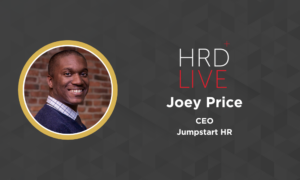Nokia Outbreak: A new way to engage and learn for leaders and teams
- 10 Min Read
When you attend a leadership training, how often does the trainer’s content relate to your actual context or pressing issues? And how often does the trainer, the expert, have the breadth of expertise to adapt their content to you and the rest of the participants? Probably, rarely or to a limited extent. Yet it is […]
- Author: HRD Connect
- Date published: Jul 19, 2017
- Categories

When you attend a leadership training, how often does the trainer’s content relate to your actual context or pressing issues? And how often does the trainer, the expert, have the breadth of expertise to adapt their content to you and the rest of the participants? Probably, rarely or to a limited extent. Yet it is now, in the Volatile, Uncertain, Complex and Ambiguous (VUCA) world we work in, that participants would benefit most from having a training that is fully adapted to their work environment and relates to their immediate challenges.
Many Leadership Development professionals bring in external trainers to deliver leadership development programs for 2-4 days offsite. The familiar design process goes something like this: identify a need, then an external trainer, then design the program and its content months before the program is delivered to a homogenous level of participants but with wide ranging back grounds, experiences, and challenges. The pre-determined content offers very little flexibility and adaptability. Often, it’s the wrong subject at the wrong time. From an employee’s view, the conventional approaches to learning are appreciated but they seem out of touch with their reality.
But it doesn’t have to be this way. An initiative launched by Nokia’s leadership development team has developed a learning experience which addresses some real external business challenges like making sense of (literally and figuratively) Artificial Intelligence, Cloud, Digitalization, and Big Data. And internal challenges which arise from external challenges like raising our ambitions, taking risks, being quick and agile, accepting failures and learning fast. The learning experience uses only internal trained facilitators to steer participant discussions around themes like leadership and teamwork within a VUCA world. It is delivered on-site over two hours. And the “content” is not predetermined. Rather it is based on the participants’ actual behaviours within a themed room. Think of a case study but it’s acted out by the participants without a script!
How successfully has it been? In just 3 months from January to March of this year 73 sessions were completed. 294 people attended and the quotes received from participants included “Inspirational and energizing!” “The possibility to receive instant feedback regarding team performance as well as individual contribution analysis was very effective.” “I was totally positively surprised how great Outbreak experience was!”
The Novelty of Nokia Outbreak
Imagine you and 5 other participants whom you know and who all work on different teams are locked in a windowless, dimly lit office room resembling a hacker’s underground world. There is a white board with some cryptic writings, old and new computer displays, graffiti on the walls and other seemingly unassociated objects. You have one hour to solve puzzles, riddles and locks that will eventually give you passage through the exit door. Now imagine you and your fellow “out breakers” succeed in getting out. As you leave behind the dimly lit room your eyes adjust to an adjacent room where you are met by your facilitator and a game master who invite you to some refreshments before sitting down to debrief and discuss your experiences.
Welcome to Nokia Outbreak! A unique, fun and social learning experience adapted from “Escape Rooms” concept. From start to finish it takes, at most 2 hours; one hour in a locked room and one hour for a debrief led with a trained, internal facilitator. Outbreak is for a maximum of 6 participants at any one time. The participants either know each other (e.g. they are peers or part of the same team) or they don’t know each other but they have something in common (e.g. they are all leaders). It’s an innovative way to engage teams and leaders to build team cohesion, to reflect on leadership, team collaboration and to relate their Outbreak experience to the challenges associated with the VUCA work environment.
A break from traditional trainings: 5 Differences
1 – The Introduction, kick-off
Typical training’s kick-off in plenary with participants settling and getting prepared for the familiar sequence of events – overview of the agenda and what participants can expect, lectures, table discussions, group exercises, back to plenary for sharing and wrap with individual commitments. In Nokia Outbreak, the introduction consists of 5-minute walk from a meeting point to the designated room. The facilitator leads the way and sets the scene in which participants are about to be thrown into. Participants are informed a Nokia IT whiz-kid has fallen out of favor and has gone underground to seek his revenge with a virus that, if unleashed, could change life as we know it. The challenge they’re told is to get out of the locked room within one hour. Lastly as they arrive and stand in front of what looks like an office door, the host gives them their final instructions: they cannot dismantle items in the room nor can they unplug any electric devices. After signing a non-disclosure form which requires them amongst other things to keep their experience confidential, the 6 enter the dimly lit room. Participants up to this point have no clue what will happen upon exiting the room. They go in without any conditioning or pre-conceived ideas of what behaviors they need to display or what the facilitator is looking for.
2 – The Outbreak Room
Even the room is unlike any training environment participants are accustomed to. Upon entering the room, a transformed office space at Nokia HQ, participants are thrown into the unexpected. The lights are dimmed, the walls are spray painted with graffiti and the windows have been covered up. There is one computer screen in sleep mode, some electronic devices with flickering lights are scattered across the room. There are books beside a computer with highlighted words and page markers interspersed in the book. There is a blank whiteboard. There is a key box hooked on one of the walls and there are four old Nokia phones locked in a Perspex incasing with red, green, yellow and blue light bulbs on each side of the box. The door, where they are meant to exit, has a security code box. And above this door is a digital clock counting down from 60 minutes. A small camera looms in the corner ceiling. This environment is truly adapted for experiential learning!
3 – Furious activities within the room
In a typical 2-4 days training environment, participants endure the necessary lectures and survive the familiar peaks and troughs and the post-lunch collective comas. In Outbreak, there is no trainer “standing” between them. The participants immediately immerse themselves with the task at hand and set about discovering the room. They simply forget about work, about who is their leader, about their roles and hierarchies. They forget about the game master and the facilitator who are both outside the room and watching them through a live video feed. They simply forget they’re at work and on Nokia HQ premises! Before they know it, times up. They’re exhilarated.
4 – The De-Brief
In trainings as we know them, exercises are usually carefully selected to go together with the course lectures to amplify the teachings. Debriefs are done by a subject-matter expert and generally refer to course materials. Outbreak debriefs are similar but with one exception: the debriefs refer to what happened in the room. The trained internal facilitator is not a subject-matter expert. He/she encourages participants to reflect on their experience through a set of questions: “How would you describe your experience?” “What did (or didn’t) you do? What was said (or wasn’t) said? How did they feel at different intervals? Why did they react the way they did at key moments in the exercise? Participants’ energy levels remain high as their immediate reflections reveal different perspectives, missed opportunities and critical moments and some laughter (who said trainings need to be dull, boring!) In between their comments, the facilitator chimes in with an ominous “let me share with you what I observed…”
5 – Relating learnings in context
The Outbreak room provides all the elements of a VUCA world and more: time pressure, then need for fast prototyping, team communication, collaboration, trust and more. With this environment, the facilitator weaves their observations and helps relate the participants’ experience back to their work environment through the following questions: “What aspects of communication would you describe as key to success in this exercise?” “Did or didn’t the team trust each other and how did this manifests itself?” “Who was/were the leader(s)? How did this get decided? And were there any changes in leadership? Why?” “How did the team manage failure? Or Success?” “Why did no on ask the games master for help?” Facilitators steer participants to commitments with questions like: “What’s behind this?” Questions like “What struck you the most,” “Why is this important to you?” and “What will you do with this insight?”
The Learning’s
In two hours, the discussions reveal what successful teams do. “Leaders” are often not the person with the authority or the title. In fact, successful teams experience a change in leadership over the course of the outbreak. Successful teams pause and reflect repeatedly from the moment they enter the room, to an impasse or after a success – they typically don’t’ allow themselves to be influenced by the need to act. Successful teams turn failures into learnings; they embrace the notion of chaos rather than approach the tasks in a linear, sequential way. They display a form of trust which manifests itself through participants challenging each other, asking questions, or asking for help from one another or from the game master. “Roles,” in this case defined by the task like solving a puzzle, are fluid; participants don’t “own” a puzzle or riddle, rather participants move about, taking turns or working in pairs or groups on a puzzle or riddle which gives access to broader perspectives. Communication is seemingly chaotic but successful team members “think out loud” sharing frustrations, discoveries, actions and failures. It’s a form of knowledge sharing in action.
- Escape rate ~55%.
- Average amount of hints provided per group: 2,5
- Time to beat:41 minutes (no hints), 43 minutes (only 1 hint)
Conclusion
Nokia Outbreak is unlike conventional e-learnings, webinars or face to face learnings. Borrowed from Escape Rooms, participants are locked into a themed office space at Nokia HQ to solve puzzles, riddles and unlock locks to escape a room within a set time. The behaviors, actions and exchanges that transpire within the room become the basis for discussions and learnings in the form of a debrief around timely and relevant themes related to the VUCA world. Discussions help employees and leaders explore how they can manage and lead successfully up-wards, downwards and across peers when they don’t necessarily have a clue what to do, when the others have the knowledge, when (un)learning is critical for success and trust is required for success. The Nokia Outbreak essentially puts the participants and their experience front and center as a learner and teacher in a fun social setting.
_____________________
Nokia has continued its investment in leadership development and is continuously redefining its ways to develop its leaders through coaching, experiential discovery programs and a program focusing on adapting to complexity which recently won the efmd Excellence in Practice Gold Award. Joel Casse is Global Head of Leadership Development. His team oversees corporate leadership programs, Nokia’s leadership framework and assessments. He is based in Munich, Germany.
.









